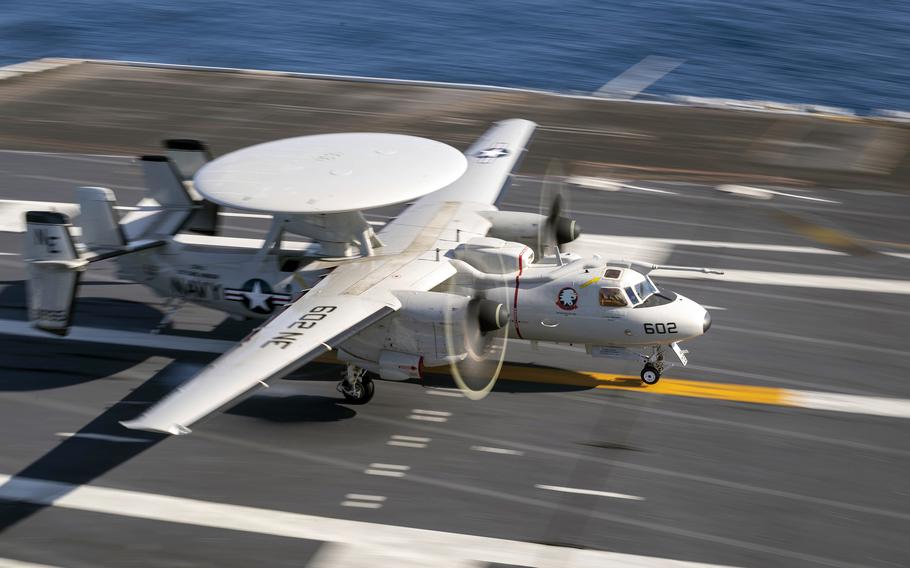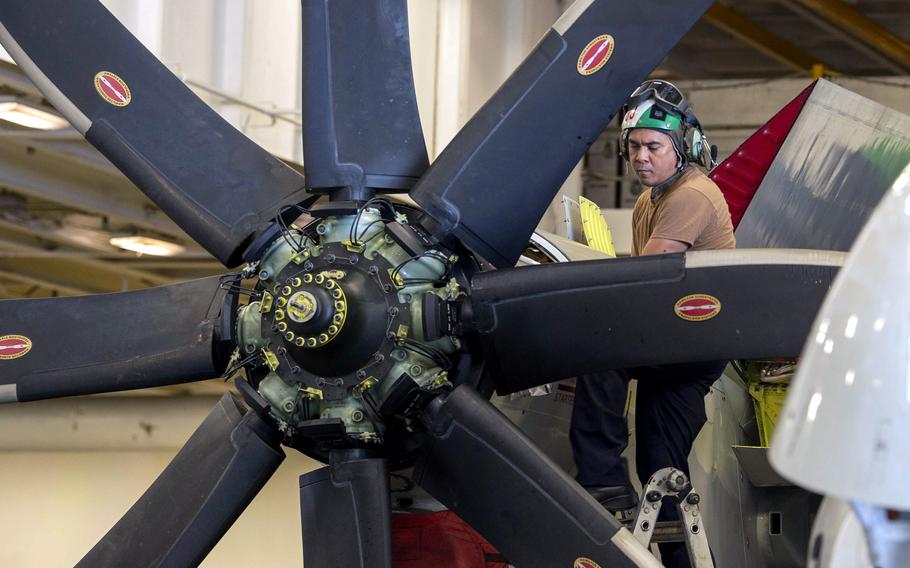
An E-2D Advanced Hawkeye lands on the flight deck of the aircraft carrier USS Carl Vinson while underway in the Pacific Ocean, June 12, 2024. A Defense Department Inspector General report found the Navy isn’t tracking deficiencies discovered during operational testing of the aircraft. (Joshua Sapien/U.S. Navy)
The Navy’s battle manager in the sky has been crippled by scores of deficiencies and no plan to fix them, the Defense Department Inspector General said in a report that cast doubt on whether the service can accomplish critical missions at sea.
The E-2D Advanced Hawkeye aircraft, easily recognizable for the dish-shaped antenna mounted above its fuselage, delivers air and missile defense data to aircraft carrier groups, among other roles.
However, the Navy “is budgeted to spend $22 billion to acquire a total of 80 (E-2D) aircraft and has already fielded 62 aircraft that do not meet the required performance capabilities,” the IG said.
That’s because the Navy isn’t tracking problems found during operational testing, the report determined.
The IG found 141 operational deficiencies weren’t fixed as of February. That’s about two-thirds of the total deficiencies found during seven operational tests performed from 2011 to 2020, the report noted.
The critical shortfalls were mostly redacted but in citing one such problem, the IG noted that “the radar is the aircraft’s primary means to detect and track land and sea contacts.”
The few deficiencies released publicly included problems with crew seats locking into place for landing aboard an aircraft carrier, and an obscured view on a tracking screen that affected the crew’s ability to detect an object as soon as possible.
The first E-2D was delivered to the Navy in 2007 by Northrop Grumman, which continues to manufacture and upgrade the aircraft it calls the Navy’s “digital quarterback.” Acquisition is expected to finish in 2026 with the Navy planning to fly the aircraft into the 2040s, according to the IG report.

Petty Officer 1st Class Luis Esguerra conducts maintenance on the propeller of an E-2D Advanced Hawkeye in the hangar bay of the aircraft carrier USS Carl Vinson in the Pacific Ocean in 2023. The Navy doesn’t have a plan to address or correct deficiencies discovered during operational testing of the aircraft, according to a Defense Department Inspector General report released Sept. 23, 2024. (Jeff D. Kempton/U.S. Navy)
The Navy contracted with Northrop Grumman to provide software and hardware modifications from 2014 to 2027. Those modifications include improvements to radar, satellite communications and electronic protection, among other upgrades, the IG said.
The report also found that of the 141 unaddressed deficiencies, about 45% were considered to have a critical or serious impact to mission success. Another 34 deficiencies not covered by the IG’s report were reported in May.
The IG also noted that DOD’s office of the director of operational test and evaluation, or DOT&E, has consistently reported reliability issues with the aircraft’s radar and the inability of the Navy to keep the aircraft maintained and available.
“The DOT&E recommended that the Navy correct these issues but as of 2024, the recommendations remained unresolved,” the IG said. “These limitations may preclude the E-2D Advanced Hawkeye from accomplishing the mission requirements.”
The E‑2/C‑2 Airborne Command and Control Systems Program Office, or PMA-231, which is responsible for tracking the deficiencies, admitted it didn’t have a central system allowing it to do so.
The IG recommended that the Navy establish a process to track the aircraft’s deficiencies. The report also said the service should evaluate all unresolved deficiencies and note whether action was taken.
The Navy also should create a plan to correct the deficiencies that impact mission accomplishment, the IG said.
The Navy concurred with the recommendations and said all actions would be completed by Dec. 1.